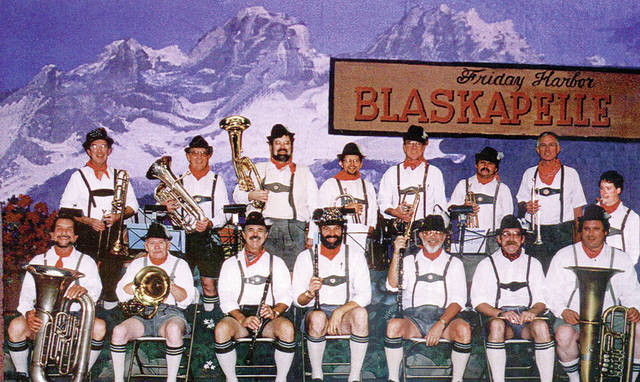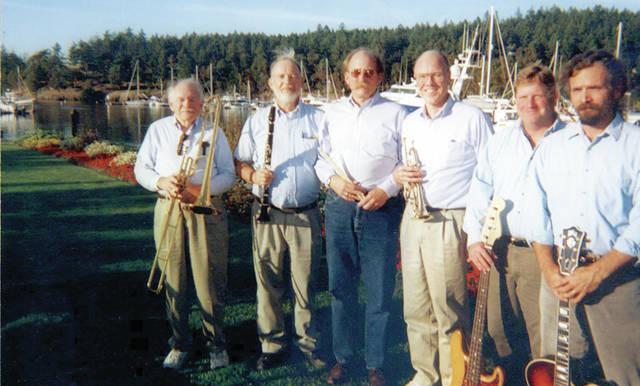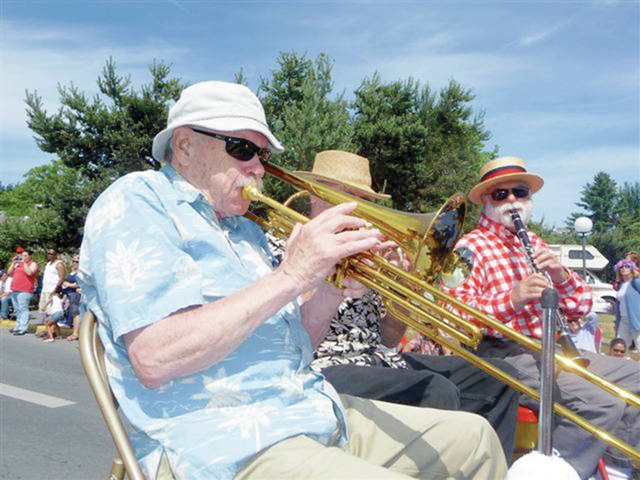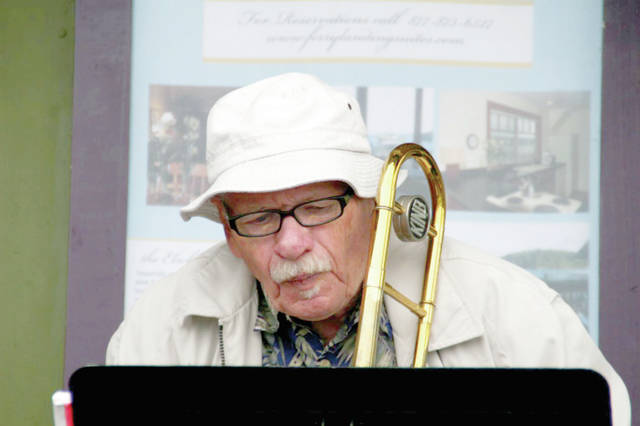Talk Story with Bill Bryner

Photo courtesy Bill Bryner
Bill Bryner (bottom row, second from left) played German-style music with an Octoberfest band in the 1980s.

Photo courtesy Bill Bryner
Bill Bryner played with the Argyle Street Jazz Band on Washington state’s San Juan Island.

Photo courtesy Bill Bryner
Bill Bryner performs in a Fourth of July parade in Washington state sometime in the 1990s.

Photo courtesy Bill Bryner
Bill Bryner, left, on trombone, performs Dixieland-style music with the Argyle Street Jazz Band in Washington state.

Photo courtesy Bill Bryner
Bill Bryner carefully studies music while rehearsing with Kauai’s longest-running band, the Starlighters, before they disbanded in 2017.

John Steinhorst / The Garden Island
Ninety-one-year-old Lihue horn player Bill Bryner loves to play music and talk story.
Kauai swing trombonist Bill Bryner has been playing music for more than eight decades. During that time he has been a student, teacher, cavalry rider, radio operator, weather observer, engineer, computer programmer and an inspiration to all.
Kauai swing trombonist Bill Bryner has been playing music for more than eight decades. During that time he has been a student, teacher, cavalry rider, radio operator, weather observer, engineer, computer programmer and an inspiration to all.
Now the retired 91-year-old Lihue resident continues to work closely with young college musicians, as well as performing with the Sunset Swing Band. His dedication to teaching and playing music equals his penchant for talking story and relating his diverse adventures throughout Illinois, Kansas, Virginia, Germany, Kentucky, California, Washington, Oregon and finally Hawaii.
Tell us about your beginnings in life and in music.
I was born into a very small town in Central Illinois, and it was a music town of 1,400 people. From the beginning, my family back in the 1800s played in it. Every Wednesday night during the summer, the main street would fix an intersection in the middle and string up lights. The high school band and some of the people that had graduated would come and play a concert, and the farmers would come and buy groceries in the town. I can remember being in a bathtub as a little kid and wanting my mother to hurry, so I could get down to the concert. When I was in fourth-grade, I started playing baritone horn. That was my start into music, and then I played all the way through high school.
When I was graduated, I immediately got drafted into the Army in 1945, right at the end of World War II, and sent to Fort Riley, Kansas, to be in the horse cavalry. It was the last increment of horse cavalry to ever go through the United States Army, and I was in the Calvary Replacement Training Center. They trained radio operators, of which I was one, and mule skiners, people who packed mules, to go over the hump in China during World War II. Neither lasted all that long, but we did ride horses. We did the same thing the cavalry had done on McClellan saddles, which are like two boards with a hole in the middle. It was an interesting experience. When I was just a couple weeks from my basic training, they dropped the bomb, so the war was over.
At the end of my basic training, they sent me to the advanced radio school at the main fort where there was a device for encoding. Then they sent me to Fort Pickett, Virginia, to learn how to control crowds and stuff like that, then over to Germany. I was in the Army of Occupation until November of 1946.
What did you do after you served the Army?
I went back to music and studied at Illinois Wesleyan University and got a bachelor of music degree in 1950. I taught music in Central Illinois at two different schools for four years. Then I found out engineers were making two and a half times what I was making as a teacher. So I went back to the University of Illinois and studied engineering. I worked for a very interesting guy for a year and a half and became the weather observer for Champaign-Urbana, where the university is located. I spent until 1957 at the University of Illinois, then got an offer for Douglas Aircraft to work for them. I worked for them until 1960.
Douglas Aircraft was very involved in the Sidewinder missile. I was sent out to China Lake, which is a naval ordnance test station, to do the calculations on testing of the Sidewinder missile. The Navy had just got a new fighter plane, called the A4D, and they only had one of them. But they had a bunch of A3Ds that couldn’t go as fast. In order to get up to speed, they put an afterburner on the A3D, which would boost it up to go as fast. Being a heat-seeking missile, they had to heat the target or the A3D would be shot down. So they had this long cable on and when they got up to test the missile, the A3D kicked in the afterburner, which burned off the tow cable. The target was such a complex thing that they only had one of them, and it disappeared some place in the desert. All summer they looked for the tow target but could never find it all the time I was there.
How did you get into computer programming as well?
I had taken a course at UCLA and got into computing. Douglas had me write a program for them, and the company that produced the computer that I wrote it on asked me to come interview for a job. They had a computer that I had written that program onto to find out about the metal breaking. In 1960 I started working for Royal McBee, who built typewriters and computers, for a short time.
After that, I worked for Bendix Computers, then went to a company which built the computer that would fit down the Coney Tower on a submarine. I helped to design a Fortran for that computer. I worked for a guy at Bendix who was a second line manager, and one day I went up to get my mail, which was next to his office. He started chewing me out for a program I had nothing to do with. I didn’t even work on that project, so I left and started working at TRW. My manager started his own company and left. Guess who came in as a second line manager, my previous manager at Bendix.
They automated all kinds of things, including power plants, and I helped to automate Paradise Kentucky Power Plant. It isn’t paradise, it’s just the opposite. I spent a whole summer there dealing with programmers and engineers determining whether “or” is the inclusive “or” or the exclusive “or.” My manager there was not all that happy with me for not understanding the definition of “or.” I got an offer from IBM, so I went to IBM and helped write the first IBM 360 Assembler in 1965.
You’ve held some interesting jobs. Tell us about your personal life as well.
My wife and I met while I was in college at Wesleyan University. In fact we graduated in the same class. We had two children, then we had a third child while we were living in California. I took early retirement from IBM in 1981. Up until the 1990s, I was consulting all over Silicon Valley for various companies. I wasn’t professionally doing music, it was all for fun and still is.
My wife and I had divorced back in 1957, and I had married another woman who had two children, my stepdaughters. She had studied to be a concert pianist, and so when we got together we played music. There wasn’t much music written for trombone and piano. I learned how to play flute when I was in college, so I picked up flute again and we ended up playing a lot of Baroque music.
We were musicians together and she had started taking music lessons at Cabrillo College in Santa Cruz, California. In 1981, it was recession year, very bad for consulting in Silicon Valley. So, I just went back to school for a couple years and studied music again at Cabrillo College with a guy who had been the trumpet player for Stan Kenton in the ’70s. His wife was teaching classical music there, so my wife and I studied with them. That was how I got back into music really strongly.
Why is playing music such an important part of your life?
When I grew up there was no television, it was all radio. At night, almost any station you tuned into had swing music on. Chicago had two ballrooms, and every night they broadcast from both. It was the big-name bands of the time, so I loved that music. When I was in seventh-grade, it was the last national band contest in Battle Creek, Michigan. Bands all over the country who got first at state would be invited to the national band contest. My teacher invited me to be a part of that, and there were two high school guys that were playing baritone horn with me. They said, “If you blow a single note during this, we’ll beat the living daylights out of you.” So I wiggled my fingers rather than blowing, but I was in the last national band contest that ever happened.
When did you begin taking on a more serious musical career?
When I had gone back to school in Illinois, I had been a radio operator. I’m a member of a national music fraternity, which was also social on that campus. All the rest of the people coming back had been in big bands all over the world, playing in these big bands in the Army and Navy. So, I didn’t get to play in any of the swing bands at that time. But I love that swing music.
So this time I was studying with this guy and I took improv classes, arranging classes and all the music courses from him. My wife also studied with him, so we played jazz together. We started a big band in Yachats, Oregon, that’s still going since 1992. It’s a town of 600 people.
What attracted you to the small community of Kauai?
I have a daughter from my first wife who has two daughters, and one of them had been here almost since she graduated from high school. My daughter Martha came here to live after she got her divorce. So I came to join them. One has left the island, but the other is a Chinese medicine practitioner here.
I lived in the little town of Boulder Creek in Silicon Valley until the earthquake did a bunch of damage to my home. My wife and I decided not to live there any more, so in early 1990 we moved to Yachats, Oregon, first.
I just had a major operation a week before, taking a fatty tumor off my spine. I was lying in bed, but the World Series was going to start. I had to go out, and as I was turning the antennae, everything was shaking and the side of my house was moving. I ran to get away from it, fell down, and when I came to my dog was over me standing over me shaking.
What kind of musical expressions did you find in Hawaii?
I had decided to come here to live, so I was renting an apartment, and my daughter said I should go down and play in the college concert band. So I went down and joined the band. The guy standing next to me, playing bass, asked if I’d like to play in a swing band. He invited me to play with the Starlighters. I had my house up for sale on San Juan, and four years later it finally sold. That’s when I came back and played with them as I am now.
What brought you back to Kauai after leaving for four years?
This is a place of aloha. I find the people warm, friendly, loving, kind. My experience here has been filled with that. It’s just a loving place, where the people are generous. I grew up in a town of 1,400 people where everybody knew everybody. It wasn’t the same at all, but I had experienced that kind of warmth in that little town. Here I feel it’s more general, the warmth and aloha spirit.
As a musician, do you have any future projects?
I think it would be interesting having a Dixieland group here on the island, because I’m sure there’s never been one before. I play with a concert band from the college, and that is just another part of my life. My ears are really bad, and the young fellow that sits next to me helps me understand where they’re starting and stuff like that. Every once in awhile I help him with the key signature.
What advice would you offer to young aspiring musicians?
Practice daily, learn all the scales in all the keys. Depending on what kind of music you like or want to learn, I would advise you to learn all kinds of music. Swing is sort of on its way out, so listen to old recordings of the big bands from the 1930s and 1940s to get the feel of what swing is, because most of the people who I run into today do not have the feel. If you want to learn how to play swing, listen to the old music.

